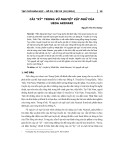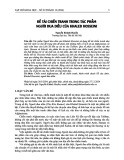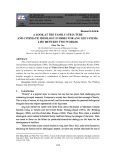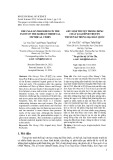HNUE JOURNAL OF SCIENCE Social Sciences 2024, Volume 69, Issue 3, pp. 31-41 This paper is available online at https://hnuejs.edu.vn DOI: 10.18173/2354-1067.2024-0046
THE CAFÉ IN PATRICK MODIANO’S NOVELS: A HETEROTOPIA OF MEMORY
Received June 14, 2024. Revised July 18, 2024. Accepted August 12, 2024.
Tran Thanh Nhan PhD Student K40, Faculty of Philology, Hanoi National University of Education, Hanoi city, Vietnam Corresponding author: Tran Thanh Nhan, email: tranthanhnhan133@gmail.com QUÁN CÀ PHÊ TRONG TIỂU THUYẾT CỦA PATRICK MODIANO: MỘT THA XỨ KÍ ỨC Trần Thanh Nhàn NCS K40, Khoa Ngữ văn, Trường Đại học Sư phạm Hà Nội, thành phố Hà Nội, Việt Nam Tác giả liên hệ: Trần Thanh Nhàn, email: tranthanhnhan133@gmail.com
Ngày nhận bài: 14/6/2024. Ngày sửa bài: 18/7/2024. Ngày nhận đăng: 12/8/2024.
Abstract. The space or landscape, particularly cafés, is a significant sign in Patrick Modiano’s novels and one of the defining characteristics of his identity in French literary circles as well as in the literary world. Most studies have examined the café space from a psychological perspective or through the lens of Bakhtin's chronotope theory. narrators However, or since Modiano’s flaneurs and protagonists often appear as inadvertently these approaches rememberers, dismiss the inseparable relationship between the three mentioned themes: place-memory-identity. Drawing on Michel Foucault’s theory of heterotopia and Pierre Nora's concept of lieux de mémoire, this article considers the café space in Modiano's novels as a place of memory, or more precisely, a heterotopia of memory. Through this lens, places in general, and the café in particular, is not merely a cocoon of emotion for the characters but rather a museum of memory, a heterotopia for the forgotten. They preserve personal memories and the connections between the subject and the society and environment. The surrounding disappearance of these heterotopias reflects the fragmentation of urban space caused by the acceleration of history and time. Through this, readers recognize fractures in the process of establishing identity as well as in the relationships between people.
Tóm tắt. Không gian, nhất là các quán cà phê, là một kí hiệu quan trọng trong tiểu thuyết của Patrick Modiano và là một trong những đặc trưng nhận dạng danh tính của ông trên văn đàn Pháp nói riêng và thế giới nói chung. Phần lớn công trình nghiên cứu đều nhìn nhận không gian cà phê từ góc độ tâm lí học hoặc khu biệt về các dạng không - thời gian (chronotope) theo quan điểm của Bakhtin. Tuy nhiên với motif nhân vật lãng du (flâneur) và kẻ hồi tưởng (rememberer), hướng tiếp cận như thế đã vô tình bỏ qua mối quan hệ mật thiết vốn không thể tách rời giữa ba vấn đề phổ biến trong tiểu thuyết của Modiano: không gian-kí ức-căn tính. Từ lí thuyết về tha xứ (hétérotopie/ heterotopia) của Michel Foucault và địa bàn kí ức (lieux de mémoire) của Pierre Nora, bài viết hướng đến xem xét không gian quán cà phê trong tiểu thuyết Modiano như là một không gian kí ức, hay đúng hơn là tha xứ kí ức. Qua đó, không gian nói chung, quán cà phê nói riêng, dưới cái nhìn của Modiano, vừa phóng chiếu nội tâm vừa là bảo tàng kí ức, một tha xứ cho những kẻ bị lãng quên. Nơi đây lưu giữ kí ức cá nhân cùng mối liên hệ giữa chủ thể với xã hội và môi trường xung quanh. Sự thay đổi, biến mất của những tha xứ kí ức này phản ánh một không gian đô thị tan rã do quá trình gia tốc của lịch sử cùng thời gian. Qua đó độc giả nhận ra sự đứt gãy trong quá trình xác lập căn tính cũng như trong mối liên hệ giữa người – người.
Keywords: Patrick Modiano, heterotopia, site of memory, Pierre Nora, Foucault, café, memory,…
Từ khóa: Patrick Modiano, tha xứ, địa bàn kí ức, Pierre Nora, Foucault, quán cà phê, kí ức,…
31
TT Nhàn
1. Mở đầu
Một trong những dấu chỉ kí ức được con người ý thức và sử dụng sớm nhất chính là không gian. Thậm chí, đối với chủ thể ghi nhớ mà nói không gian không thể tách rời với kí ức. Theo Paul Connerton (nhà nhân chủng xã hội học nổi tiếng với các công trình liên quan đến kí ức xã hội và kí ức cơ thể), điều này được lí giải thông qua sự tồn tại một dạng kí ức mà ông gọi là: kí ức không gian/kí ức nơi chốn (place memory). Ông cho rằng kí ức không gian hay kí ức xây dựng dựa trên yếu tố địa hình (topography) vốn bắt nguồn từ nghệ thuật hùng biện. Về cơ bản loại kí ức này xuất phát từ một kĩ thuật ghi nhớ bằng cách gán những điều cần nhớ với các địa điểm hay không gian nhất định hoặc hình ảnh trong tâm trí [3; 4]. Bằng cách này vị trí không gian sẽ lưu giữ kí ức mà ta gán cho chúng. Song, các nhà xã hội học đã nhận ra sự dịch chuyển trong cách quan niệm về không gian cũng như mối quan hệ giữa không gian với con người. Quá trình phi trung tâm hóa thời hậu hiện đại đã kéo theo cả sự tan rã của không gian, do vậy mà cảm thức không gian (sense of place) của con người lúc này đã khác trước rất nhiều. Với Yi-fu Tuan, không gian là trải nghiệm: “Mỗi một địa điểm là một trung tâm hội tụ ý nghĩa được cấu thành bởi trải nghiệm… - thứ vốn khước từ sự khách quan hóa” [4; 152]. Hay với Cheryll Glotfelty, không gian là những mối liên hệ và là những câu chuyện. Không gian, chính xác hơn là một địa điểm, một cảnh quan về bản chất là chưa hoàn bị và luôn trong quá trình hình thành. Cùng với đó, làn sóng di dân và sự giao thoa văn hóa, con người không còn quá gắn bó với một địa điểm duy nhất. Những cụm dân cư vỡ ra mang theo những mảnh vỡ không gian, kí ức (văn hóa) của họ đến mọi nơi. Tất thảy những thành tố ấy đều mang động năng, thay đổi không ngừng; cũng có nghĩa là không gian giờ đây không còn được nhìn như một yếu tố tĩnh tại, bất biến nữa, mà nó rất có thể sẽ tan rã theo cơn lốc di cư ấy. Theo lẽ đó, sự thay đổi về không gian sẽ dẫn đến sự thay đổi về kí ức, cũng tức là biến đổi về sự quên (bởi ghi nhớ là một quá trình chọn lọc, nên nhớ cũng là quên). Connerton khẳng định quá trình lãng quên của con người hiện đại gắn liền với quá trình tách rời cuộc sống xã hội khỏi nơi chốn (locality): “Có một sự biến đổi sâu sắc trong những ý nghĩa cuộc sống vốn được xây dựng dựa trên kí ức chung (shared memory), các ý nghĩa ấy đang bị xóa nhòa bởi sự biến đổi cấu trúc trong không gian sống (life-space) hiện đại” [3; 5]. Nói cách khác, thay đổi cấu trúc không gian, hay quan niệm về không gian, trực tiếp hoặc gián tiếp, có ảnh hưởng, đôi khi là thay đổi về kí ức, và xa hơn là căn tính cá nhân, thậm chí là cộng đồng.
Nhận thức được thực tế này, ta quay trở lại các sáng tác của Modiano để có thể nhìn nhận yếu tố không gian ở đó không đơn thuần chỉ là nơi bao chứa hoạt động của nhân vật. Ông đã nhiều lần để nhân vật trực tiếp phát biểu ảnh hưởng hay ấn tượng mạnh mẽ mà các chi tiết địa chí tác động lên kí ức: “Nhưng các chi tiết địa chí gây một hiệu ứng gần gũi và rõ ràng hơn, chúng lại tạo ra một cảm giác xé ruột về những mối dây bị cắt đứt và sự trống rỗng” [5; 41]. Như thế, không gian cùng lúc gợi lại trong nhân vật hình ảnh của quá khứ, và làm cho quá khứ ấy trở nên sống động trong tâm trí bởi mang lại cảm xúc mạnh mẽ ở thực tại. Xuyên suốt 50 năm cầm bút, vai trò của các yếu tố không gian chưa từng giảm sút mà ngược lại, nó trở thành phương tiện biểu lộ cái nhìn của nhà văn đối với vấn đề kí ức theo thời gian. Trong Chevreuse, cuốn tiểu thuyết vừa xuất bản năm 2021, Modiano không những khẳng định trực tiếp : “cấu trúc [không gian/địa hình - la topology] giúp ta khơi dậy những kí ức sâu thẳm nhất”. Ông thậm chí gắn số phận của nó với sự lãng quên cũng như cái chết của hồi ức trong ta: “Vào thời đó, anh [Bosmans] không khi nào thôi rong ruổi khắp Paris trong thứ ánh sáng lân quang làm sống động cả con người và cảnh vật. Dần dà về sau, khi lớn lên, anh nhận thấy ánh sáng ấy ngày càng yếu ớt […]. Những có lẽ sau ngần ấy năm, thế giới và những con phố đã thay đổi đến độ chẳng còn có thể gợi lên chút gì trong anh nữa” [6].
Một vài trích đoạn vừa đủ để thấy được vai trò của không gian đối với kí ức dưới cái nhìn của Modiano. Sự thay đổi về cấu trúc đô thị đã làm biến mất “nguồn gốc vật chất” (theo Bergson) hay “địa bàn kí ức” (theo Pierre Nora). Do đó, nhân vật như ở trong một thế giới xa lạ. Nếu hình dung không gian như cầu nối đem hồi ức trở lại thực tại thì sự biến mất của chúng vô tình tạo ra
32
Quán cà phê trong tiểu thuyết của Patrick Modiano: một tha xứ kí ức
một sự đứt gãy, thậm chí là vênh lệch đến mức làm bối rối chủ thể. Song, phần lớn các công trình nghiên cứu đều dừng lại ở việc xem xét không gian trong tiểu thuyết của Modiano từ góc độ tâm lí, cấu trúc nội tại hoặc đánh giá chúng theo các motif không-thời gian (chronotope), dẫn đến bỏ qua vai trò như một di chỉ kí ức của nó.
Để lấp đầy khoảng trống nghiên cứu đó, bài viết nhìn nhận không gian, cụ thể là các quán cà phê dưới quan điểm của Michel Foucault về tha xứ - một dạng không gian hóa các mối quan hệ xã hội và lí thuyết về địa bàn kí ức của Pierre Nora. Cũng tức là đặt không gian quán cà phê trong bối cảnh lịch sử, xã hội cũng như trong văn hóa đương thời để chỉ ra rằng: vượt ra ngoài phạm vi tâm lí cá nhân, không gian trong tiểu thuyết của Modiano còn mang tính xã hội. Bằng sự quan sát và cảm quan nhạy bén, ông đã nắm bắt và tái hiện “sự biến đổi cấu trúc” trong không gian đô thị Paris. Qua đó, nhà văn thể hiện những biến chuyển trong cách mà con người hiện đại, nhất là các thị dân nơi các thành phố lớn, thực hành ghi nhớ và định hình bản sắc cá nhân.
2. Nội dung nghiên cứu
2.1. Không gian (của) kỉ niệm: Tha xứ kí ức và địa bàn kí ức
“Hétérotopie/heterotopia” (tạm dịch: Tha xứ, dị xứ) là một khái niệm được Foucault lần đầu nhắc đến trong lời mở đầu cho công trình Trật tự của sự vật (Les mots et les choses : Une archéologie des sciences humaines/The Order of Things) [7] với đối tượng bàn luận là ngôn ngữ. Tuy nhiên, tha xứ về sau lại được ông diễn giải cụ thể hơn trong bài viết Những không gian khác (Des espaces autres/The Other Spaces) – vốn là bài giảng cho một nhóm sinh viên kiến trúc. Trong đó, tha xứ được xác định như là các địa điểm thực tồn, “những nơi được tạo thành ngay từ sự thiết lập xã hội, và chúng là một kiểu phản-địa điểm (counter-sites), một kiểu phi xứ được hiện thực hoá (effectively enacted utopia) mà ở đó mọi địa điểm thực tồn khác, những địa điểm có thể được tìm thấy trong văn hoá, đều được trình hiện (represented), bị thách thức (contested) và bị lật ngược” [8; 24]. Tựu chung, về cơ bản tha xứ là một dạng không gian hóa của thiết chế xã hội. Các thiết chế này được biểu lộ qua cách bài trí, mối quan hệ của tha xứ với các nơi chốn khác cũng như các hành vi, hoạt động diễn ra trong tha xứ. Tha xứ không chỉ có quan hệ mang tính vật chất hữu hình với các nơi chốn khác mà có mối liên hệ về thời gian. Foucault đưa ra 5 dạng tha xứ phổ biến: (1) tha xứ ngưỡng (hétérotopie de crise): tồn tại trong những xã hội cổ sơ (primitive societies), là một nơi đặc biệt, thiêng liêng hoặc cũng có thể là những vùng cấm dành cho những người đang ở trạng thái ngưỡng: tuổi dậy thì, mang thai, phụ nữ có kinh nguyệt, người già,… Tuy nhiên, Foucault cho rằng những tha xứ ngưỡng đã biến mất theo thời gian và bị thay thế bởi (2) tha xứ lệch pha (hétérotopie de déviation). Tha xứ lệch pha là nơi mà ở đó cá nhân có những hành vi lệch chuẩn, chẳng hạn như bệnh viện tâm thần, nhà tù, bệnh xá,… Các loại tha xứ còn lại không có tên gọi cụ thể nhưng có thể diễn giải ngắn gọn như sau: (3) Tha xứ có khả năng bao chứa nhiều không gian khác nhau cùng một chỗ mà bản thân các không gian đó mâu thuẫn với nhau. Điển hình như rạp chiếu phim, nơi mà các không ba chiều khác nhau tụ hội trên một màn ảnh hai chiều trong một căn phòng duy nhất. (4) Tha xứ sở hữu tha thời (heterochronies), chất chứa trong nó nhiều lớp/dòng thời gian khác nhau mà bảo tàng và thư viện là những nơi tiêu biểu. Sau cùng Foucault nhắc đến (5) tha xứ của nghi lễ - những địa điểm đảm nhiệm chức năng đặc biệt khác với không gian môi trường xung quanh chúng, chẳng hạn như các khu nghĩa trang [8;24-26].
Dựa trên diễn giải của Foucault về các loại tha xứ, có thể nói quán cà phê trong tiểu thuyết của Modiano cùng lúc mang trong mình đặc trưng của tha xứ thời gian, tha xứ ngưỡng lẫn tha xứ lệch pha. Biểu hiện cụ thể ra sao sẽ được làm rõ ở phần tiếp theo, song nói như thế để thấy rằng, không gian trong sáng tác của Modiano nói chung và không gian quán cà phê nói riêng, bản thân nó là tấm gương phản chiếu các thiết chế, mối quan hệ xã hội giữa các nhân vật, rộng ra là con người hiện đại. Hơn thế, là một địa điểm sở hữu khả năng làm đứt gãy dòng chảy thời gian trong chủ thể cũng như trong mối quan hệ với các không gian xung quanh (tha thời), quán cà phê vận
33
TT Nhàn
hành giống như một dạng “bảo tàng kí ức”. Nói cách khác, không gian cà phê trong tác phẩm của Modiano chính là một tha xứ kí ức.
Một khi không gian đã hình thành mối liên kết về mặt xã hội với kí ức như thế, thì đây cũng là lúc ta có đủ cơ sở để tiến đến xem xét nó ở mức độ hoàn thiện hơn bằng cách kết hợp với quan điểm của Pierre Nora về địa bàn kí ức. Trong công trình Địa bàn kí ức: Xây dựng quá khứ Pháp – Tập 1: Xung đột và Chia rẽ (Realms of Memory: The Construction of the French Past – Volumn I: Conflict and Division), Pierre Nora đưa ra cách nhìn thú vị mà mới mẻ về sự khác biệt giữa kí ức và lịch sử. Ông viết: “Kí ức là cuộc sống, luôn luôn len lỏi vào trong xã hội sinh thời (living societies) và tựa như một cuộc tiến hóa lâu dài, chịu sự chi phối của mối quan hệ biện chứng giữa ghi nhớ và lãng quên, không ý thức được những biến dạng mà nó đang phải chịu, dễ bị chiếm đoạt và thao túng theo nhiều cách khác nhau, […]. Kí ức luôn là một hiện tượng của hiện tại, một sợi dây ràng buộc chúng ta với hiện tại vĩnh cửu; lịch sử là sự phản ánh của quá khứ” [9; 3]. Nora cho rằng kí ức trong môi trường khởi sinh của nó không thuộc về quá khứ mà luôn dự vào một phần thực tại, khi ta sống trong nó ta không nhìn nhận nó như là kí ức mà là một thực tại kéo dài vĩnh cữu (permanent/eternal present). Nói cách khác, milieux de memoire (tạm dịch: môi sinh kí ức) dùng để chỉ môi sinh của kí ức, nơi nó hình thành và tham gia vào thực tại. Trong khi đó, lieux de memoire (tạm dịch: địa bàn kí ức) lại là “bất kì thực thể quan trọng nào, hữu thể hoặc trừu tượng, mà do ý chí con người hoặc tác động của thời gian đã trở thành một yếu tố biểu tượng cho di sản tưởng niệm của bất kì cộng đồng nào” [9; XVII]. Với địa bàn kí ức ta bước vào phạm trù của lịch sử, phạm trù các diễn ngôn phê bình, của quá trình diễn giải thay vì nhìn nhận kí ức như là chính nó. Dù Nora chỉ nhìn nhận địa bàn kí ức ở phạm vi cộng đồng (ở đây là nước Pháp), nhưng khi nhắc đến quá trình thực hành kí ức thông qua các tập quán, nghi thức hằng ngày, ta không thể không xét đến kí ức ở phạm vi cá nhân. Hơn nữa việc kí ức mất dần sự kiểm soát nội sinh đối với đời sống tập thể, cũng bắt nguồn từ việc các môi sinh kí ức của các cá nhân đang dần biến mất.
Từ quan điểm của Foucault và Nora, người viết nhận thấy không gian quán cà phê trong tiểu thuyết của Modiano nên được nhìn nhận ở cả hai vai trò. Với hiệu ứng địa - tâm lí (psychogeography) mà nó gây nên nơi nhân vật cùng tính chất tha thời cho thấy vai trò như một biểu tượng quá khứ của không gian quán cà phê. Mặt khác, nó còn tồn tại với tư cách là một môi sinh quan trọng hình thành kí ức ở các nhân vật. Như thế, khác hẳn “một nơi sạch sẽ và sáng sủa” hay “một quán rất được trên quảng trường St.Michel”, với các nhân vật của Modiano, không gian cà phê có nhiều điều cần nói chứ không chỉ là một cái kén nơi nhân vật trú ngụ.
2.2. Nguồn gốc của tha xứ: Từ salon đến quán cà phê
Quán cà phê đã đi vào trang văn của nhiều cây bút nổi tiếng: Ernest Hemingway, Walter Benjamin, Haruki Murakami, Charles Dickens,… cho thấy không gian này sở hữu một tính chất đặc biệt. Thực vậy, quán cà phê, nhất là cà phê ở Paris từ thế kỉ XIX đã không còn là không gian đơn thuần mà đã trở thành một yếu tố mang tính văn hóa không thể tách rời khỏi lịch sử Paris. Mặc dù quán cà phê đầu tiên trên khu phố Saint-Germain thuộc về một đầu bếp người Ý, song bầu không khí dân chủ cấp tiến sôi động lan tỏa từ văn chương nghệ thuật đến chính trị cùng với việc giới nghệ sĩ lẫn chính khách thường xuyên lui tới khu vực này đã khiến văn hóa cà phê ở Paris phát triển nhanh chóng và mang một màu sắc rất riêng. Nó tham gia vào quá trình xây dựng lịch sử văn hóa của thành phố để hình thành nên Paris mà ta biết ngày nay. Với đặc điểm vừa nêu, các quán cà phê “kiểu Paris” (Parisian) gợi nhiều liên tưởng đến các salon (nghệ thuật lẫn chính trị) từ thời Khai sáng thế kỉ 17, 18. Là một khu vực thuộc ngôi nhà, phòng khách (salon) mang tính riêng tư. Nhưng đồng thời so với các không gian còn lại nó lại mang tính công cộng hơn cả bởi là nơi tiếp đón khách khứa. Nói cách khác, phòng khách là một khu vực đặc biệt. Đây là nơi giao thoa giữa riêng tư và công cộng, nơi những bí mật (hoặc cấm kị) được hé lộ chia sẻ, và là nơi gặp gỡ giữa “mình” và “họ” – cái Khác (the Other) trong tương quan với thành viên của ngôi nhà. Những đặc tính nêu trên của các mối quan hệ diễn ra trong salon giữ và truyền lại gần như 34
Quán cà phê trong tiểu thuyết của Patrick Modiano: một tha xứ kí ức
trọn vẹn trong không gian cà phê. Như vậy, ngay từ tiền thân của mình, quán cà phê đã bộc lộ nhiều đặc điểm của một tha xứ. Không gian quán cà phê, với sự tương tác giữa nhân vật – không gian, nhân vật – nhân vật, không gian – không gian, mang trong mình sự xếp chồng các vỉa tầng ý nghĩa xã hội ngầm ẩn đằng sau bao hồi ức tưởng như bé mọn riêng tư của các nhân vật. Song cấu trúc không gian đặc biệt này lại không được khai thác nhiều. Những thập niên đầu thế kỉ XX với Thế chiến 1, Paris trở thành nơi “trú ẩn” với nhiều trí thức và đường phố của nó đã trở nên bất tử, thậm chí trở thành huyền thoại, khi các quán phê đi vào trang văn của nhiều cây bút nổi tiếng. Ở đó, quán cà phê thường được sử dụng như một không gian tâm lí, một phương tiện để biểu lộ mong muốn và cảm trạng của nhân vật, tức không gian riêng tư, mang màu sắc cá nhân. Chẳng hạn, cà phê trong các sáng tác của Hemingway gắn với các tính từ tốt đẹp “sạch sẽ và sáng sủa”. Trong cuốn hồi kí Hội hè miên man, ông đã dành hẳn một mục để ghi lại cảm nghĩ về không gian cà phê ở Paris với tiêu đề “Một quán rất được trên quảng trường St. Michel”, “đó là một quán ấm áp, nhẹ nhàng, sạch sẽ và thân thiện” [10]. Có thể thấy, quán cà phê với Hemingway như một nơi trú ẩn cho những kẻ “chưa bao giờ có lòng tin và cũng không còn trẻ”, những kẻ cô đơn điếc đặc trước cuộc đời. Tại đó về đêm, họ “nhận thấy sự khác biệt”, họ lắng nghe từ hư không. Cà phê trong tác phẩm của ông như một ẩn dụ cho điều tốt đẹp giữa cuộc sống tẻ nhạt, lạc lối. Từ liên tưởng này, ta nhớ đến tiệm New York Cafe trong Trái tim là thợ săn cô đơn của Carson McCuller. Nó cũng mang dáng dấp của “một nơi sạch sẽ và sáng sủa” nhưng bầu không khí u uất, lặng lẽ và sự mong manh (vulnerability) cùng bất lực của đám khách khứa lại rõ nét hơn cả. New York Cafe ngay từ cái tên đã mang màu sắc châm biếm, một quán cà phê nơi tỉnh lẻ mang trong mình ảo mộng về New York phồn hoa. Trái với cái tên của nó, New York Cafe hiện lên ngay từ những trang đầu như một nơi cô đơn nhất thị trấn. Bởi sau này khi nhìn lại ta sẽ thấy nó phản ánh qua chính cuộc gặp đầu tiêu giữa người chủ Biff Brannon và người khách quen John Singer – một người câm.
Qua một vài phân tích sơ lược trên, có thể nói, ý tưởng rằng quán cà phê gắn với hình ảnh con người lẻ loi, ngồi một mình, hoặc cảm thấy lạc lõng u uất, hoặc muốn được một mình hoặc kiếm tìm một mối liên kết với đời mà ta có ngày nay là một “huyền thoại” được tạo nên phần lớn qua cách xây dựng không gian như trên trong các tác phẩm văn chương. Quán cà phê từ một không gian vốn mang tính xã hội cao đã bị thu hẹp trở thành không gian thiên về tính cá nhân nhiều hơn khi các tác giả có xu hướng sử dụng nó như một phông nền để bộc lộ nội tâm và phát triển tính cách của nhân vật. Nói cách khác, trước Modiano, quán cà phê đã đi vào văn chương như một hình tượng giàu sức gợi, nhưng có lẽ ông là một trong số ít nhà văn đi vào khai thác cũng như tái hiện mối liên hệ giữa nó với con người và kí ức trong bối cảnh không gian đô thị.
2.3. Tha xứ cà phê: Kí ức và sự tan rã của mối quan hệ con người, căn tính cá nhân
2.3.1. Quán cà phê: Bảo tàng kí ức
Dựa trên quá trình thực hành ghi nhớ và hồi cố, quán cà phê vừa là không gian kiến tạo kí ức vừa là nơi lưu giữ lẫn gợi nhớ quá khứ. Trước hết, với tư cách là các chi tiết địa chí khơi dậy kỉ niệm, ta có thể xem không gian quán cà phê trong tiểu thuyết của Modiano là một dạng tha xứ mà ở đó thời gian bị phân tách khỏi dòng chảy một chiều thông thường của nó so với các không gian xung quanh khác: “Tha xứ bắt đầu vận hành hết cỡ khi con người thấy mình ở vào một kiểu đứt đoạn tuyệt đối với thời gian truyền thống của mình” [8;26]. Nói cách khác, quán cà phê chứa đựng cái mà Foucault gọi là tha thời (hétérochronies) bởi nó làm sống lại một thời dĩ vãng trong người kể chuyện. Họ luôn có xu hướng nhìn nhận những quán cà phê bằng cái nhìn hồi cố hoài niệm, khiến cho các quán cà phê dưới ngòi bút của Modiano hiện lên như một bảo tàng kí ức. Nhìn từ khía cạnh này, các không gian lưu trú mà ta vừa nhắc đến ở trên cũng có tính chất tương tự song không thật mạnh mẽ và không phổ biến ở tất cả các nơi chốn mà nhân vật lưu lại. Trong khi đó, phần lớn các quán cà phê xuất hiện trong sáng tác của Modiano đều gây ra cảm giác về sự đứt gãy thời gian, bứt nhân vật và chính độc giả ra khỏi thực tại mà trở về quá khứ. Điều này được biểu lộ ngay từ cuốn tiểu thuyết thứ ba Những đại lộ vành đai (Les Boulevards de Ceinture). Bước 35
TT Nhàn
qua cánh cửa Le Clos-Foucré, người kể chuyện như bước qua cánh cửa thời gian, chìm vào thời quá vãng vậy: “Trên tường, sau quầy bar, dễ dàng nhận thấy một tập lịch kiểu xé từng ngày. Trông rõ mồn một con số 14. Không thể đọc được tháng và năm. Nhưng, khi quan sát kĩ ba người đàn ông ấy [Marcheret, Murraille, Chavel Deykecaire – bố của người kể chuyện] và vóc dáng mờ mờ của Maud Gallas, người ta sẽ thấy rằng cảnh tượng này đã diễn ra từ rất lâu rồi trong quá khứ” [11; 12]. Tính chất tha thời của quán Le Clos-Foucré được khẳng định thêm khi nó khiến người kể chuyện liên tưởng đến “một tấm ảnh cũ”, tức một kiểu đóng băng thời gian, mãi mãi dừng lại ở quá khứ. Quán cà phê gần Rạp Xiếc Mùa Đông trong Một gánh xiếc qua cũng đóng vai trò như một bảo tàng kí ức như thế. Mười năm sau cái chết của Gisèle, dĩ vãng vẫn còn lại đó qua hình ảnh người chủ quầy pha chế và những bức hình thuộc về một thời đã xa: “một trong những bức ảnh, lớn hơn những bức khác, khiến tôi chú ý […]. Và trong số họ, tôi nhận ra Gisèle” [4; 41]. Cuộc trò chuyện ngắn ngủi với con người canh giữ quá khứ đó đã khiến nỗi đau trước sự ra đi của Gisèle trở lại vẹn nguyên trong người kể chuyện đến nỗi anh đã “bật khóc một cách ngu xuẩn”. Tính quá khứ (pastness) của không gian cà phê còn được gợi lên qua cách bài trí và vị trí địa lí của chúng. Không gian quán cà phê được tái dựng trở lại với những đặc điểm của quá khứ: máy phát nhạc (jukebox), máy chơi pinball (flipper), những buổi cabaret, những tấm áp phích, sách báo hay tấm ảnh cũ,… Hơn nữa, phần lớn thời điểm diễn ra các sự kiện đều có một độ lùi nhất định so với thời điểm sáng tác cũng như thời gian truyện kể nên tính chất tha thời của chúng không những tác động lên nhân vật mà còn tác động lên độc giả. Qua đó những liên tưởng hồi cố trong quá trình đọc được hình thành và làm tăng màu sắc hoài niệm, chất “rétro” cho tác phẩm. Ta có thể thấy rõ điều này trong Ở quán cà phê của tuổi trẻ lạc lối. Chưa nói đến quán Le Condé – địa điểm trung tâm của tác phẩm, chỉ riêng khu phố Saint-Germain-des-Prés cũng đã đủ nhuốm màu hoài niệm lên trang văn. Khu phố Saint-Germain gắn liền với các quán cà phê như Les Deux Magots, Café Flore, Le Bonaparte,… từng là nơi ra đời của nhiều phong trào nghệ thuật, văn chương, thậm chí là chính trị ở Paris thế kỉ XIX. Ngoài việc xây dựng không gian tác phẩm trên con phố văn hóa này, đôi khi nhà văn còn tham chiếu quán cà phê trung tâm Le Condé với những địa điểm có thật trong quá khứ. Điển hình là La Pergola, một quán cà phê nổi tiếng vào những năm 1960. Sự biến mất của nó mang theo sự thay đổi chóng mặt của đại lộ Champs-Élysées cũng như cả một thời đại trên đất Pháp. Tính quá khứ của quán cà phê nằm gần Rạp xiếc Mùa Đông trong Một gánh xiếc qua mà ta vừa nhắc ở trên cũng được cấu thành phần nào từ chính vị trí của nó. Rạp xiếc Mùa Đông (Cirque d’Hiver) là một địa điểm giàu tính lịch sử và văn hóa của Paris, những bức ảnh ở quầy bar cho thấy quán phê không tên từng là điểm đến quen thuộc của những nghệ sĩ trong rạp xiếc. Với mối liên hệ này, quán cà phê trở thành nơi lưu giữ kí ức của cả một thời kì vừa huy hoàng vừa lạ lùng của Paris.
Bên cạnh bầu không khí và nơi chốn, tha thời còn biểu hiện ở chỗ quán cà phê của Modiano là nơi gặp gỡ với cố nhân. Không ở đâu mà các nhân vật lại gặp lại những con người đã từng dự vào một đoạn đời của mình nhiều như là ở quán cà phê. Ta nhớ đến: quán Le Clos-Foucré (Những đại lộ vành đai) nơi người kể chuyện gặp lại người bố sau nhiều năm xa cách dù ông (vờ) không nhận ra cậu; đến cuộc gặp gỡ như nối tiếp từ quá khứ của người kể chuyện với một người bạn của mẹ ở Chez Malafosse (Hoa của phế tích); đến La Pergola (Ở quán cà phê của tuổi trẻ lạc lối) nơi Louki bắt gặp Mocellini – bóng ma từ cái thời cô còn lui tới La Canter; hay đó là một quán cà phê vô danh khác ở góc giao giữa Rue de Monceau với đại lộ Messine – ở đó Jean Dekker gặp lại Robert Carpentieri và rình gặp “bóng ma” của Georges Maillot trong Khu phố đã mất,… Còn rất nhiều quán cà phê khác mà ta không thể nhớ tên, nhưng motif hoạt động của nó không khác gì những nơi vừa nêu. Chẳng hạn tiệm bar - đồ uống - thực phẩm ở đại lộ Niel ngay trước văn phòng Hãng nơi mà Guy Roland tình cờ gặp lại André Wildmer - người từng tham gia vào chuyến vượt biên không thành nhiều năm trước (Phố những cửa hiệu u tối). Quán bar này cũng là chốn lui tới của các cựu dô kề, “họ trao đổi kỉ niệm bằng cách cho nhau xem những tấm ảnh quăn góc chụp những con ngựa đã bị xả thịt từ lâu” [12; 189]. Hoạt động trao đổi kỉ niệm này ở một mức độ nhất định không khác gì với hành động thuyết minh các cổ vật ở bảo tàng, ta đều kể cho nhau 36
Quán cà phê trong tiểu thuyết của Patrick Modiano: một tha xứ kí ức
nghe về những gì đã biến mất, đưa người nghe/người tham quan trở về quá khứ và đồng thời làm trình hiện trở lại một (những) đối vật vắng mặt. Cơ chế tha thời trong các khu bảo tàng cũng vì mà thế mà vận hành gần như trọn vẹn trong không gian quán cà phê ở tiểu thuyết của Modiano. Những cuộc tái ngộ ấy không chỉ không hẹn trước mà còn thường xuyên là lần gặp cuối đã khiến không gian cà phê biểu lộ khía cạnh “ngẫu nhiên, thoáng qua, ngắn ngủi và phù du” của tính hiện đại mà Baudelaire nhắc đến trong bài viết Người họa sĩ của cuộc sống hiện đại (The Painter of Modern Life) [13]. Vì lẽ đó, sự biến mất của quán cà phê gắn liền với sự biến mất của một dấu chỉ kí ức, phản ánh sự thay đổi các không gian khác theo thời gian và làm biến đổi cảm nhận của nhân vật đối với không gian xung quanh: “Tôi nhìn thấy lại (Je revois les joueurs) những người chơi bi da trên tầng hai quán Café de Cluny […]. Vào năm 1966 người ta cải tạo tất tật quán cà phê trên quảng trường và đại lộ Saint-Michel, rồi những năm gần đây một số biến thành McDonald’s […]. Cho tới cuối những năm sáu mươi, khu phố ấy vẫn giống hệt (était resté )với chính nó. Các sự kiện hồi tháng Năm 1968 mà nó là sân khấu đã chỉ để lại những hình ảnh thời sự đen trắng, chúng như thể, với một phần tư thế kỉ cách xa, cũng xa xôi gần giống các thước phim quay hồi Giải phóng Paris” [14; 37].
Hiệu ứng chuyển cảnh “flashback” này (chuyển từ thì hiện tại sang thì quá khứ) rất hay xuất hiện trong sáng tác của Modiano, nó cho thấy tác động địa-tâm lí của không gian cà phê đối với nhân vật. Đứng trước nó hoặc nơi nó đã từng hiện diện, không chỉ mang lại cảm giác hoài niệm mà còn có cái nhói đau âm ỉ bởi chứng tích cuối cùng đã bay biến. Sự biến mất của các quán cà phê như mang theo những vị khách của nó cùng cả một quãng quá khứ vào hư không, vào quên lãng.
Như thế, tha thời đảm bảo tư cách bảo tàng kí ức của quán cà phê đối với quá trình hồi cố của nhân vật, nhưng đó chưa phải là tất cả. Bởi như đã nói, đây còn là không gian diễn ra nhiều sự kiện quan trọng trong đời nhân vật, tham gia kiến tạo phần lớn kí ức được tái hiện xuyên suốt tác phẩm. Nói cách khác, giờ đây ta ngược thời gian để nhìn nhận quán cà phê không phải là một địa bàn kí ức (lieux de memoire) mà như là “môi sinh” của kí ức (milieux de memoire). Với tư cách là môi trường sinh hoạt của nhân vật, nơi diễn ra những sự kiện mà sau này nhìn lại nó chính là kí ức của họ, không gian quán cà phê được Modiano xử dụng không chỉ như nơi mang tính riêng tư (private) mà còn giao thoa với tính chung, cộng đồng (public) bởi sự tương tác của người kể chuyện với các nhân vật khác diễn ra bên trong nó. Chính điều này đã làm cho quán cà phê của Modiano vừa chân thực thân quen song vẫn có sự độc đáo riêng đủ để nó trở thành một trong những biểu tượng cho tên tuổi của nhà văn. 2.3.2. Quán cà phê: Môi sinh kí ức và tha xứ của kẻ bị lãng quên
Trên cơ sở đối sánh này, ta trở lại với vai trò là môi sinh kí ức của không gian cà phê trong tiểu thuyết Patrick Modiano. So với các nhà văn khác, quán cà phê trong sáng tác của Modiano mang màu sắc triết học và phản ánh nhiều vấn đề xã hội rõ nét hơn dù rằng nó được tái hiện phần nhiều qua kí ức cá nhân. Trước hết, như đã từng nhắc đến trước đó, quán cà phê cùng với đó là hình tượng người kể chuyện mang dáng dấp kẻ lãng du chịu ảnh hưởng không nhỏ từ những gì mà Baudelaire trình bày trong Người họa sĩ của cuộc sống hiện đại [13; 390-435]. Nó không đơn thuần chỉ là phương tiện biểu lộ cảm trạng nữa mà trở thành một móc xích trong mạng lưới cuộc sống hiện đại. Tương tác giữa các nhân vật xây dựng trong nó một xã hội thu nhỏ.
Nhưng như đã phân tích, xã hội đó là xã hội bên lề - thế giới của sự lãng quên với những kẻ lạc loài. Ta nhìn thấy điều này trong đám khách khứa của Le Clos-Foucré: Trong mắt dân làng họ là “đám người mờ ám” với một nữ quản lí “chắc chắn từng là bà trùm một nhà thổ”, những quý tộc giả hiệu “có dáng dấp của một gián điệp” và dính dáng đến “các vụ truy tố pháp luật”. Đó là “một băng cướp” và “Le Clos-Foucré cũng mang dáng dấp một nhà chứa với kiểu khách hàng như vậy” [11; 28]. Hay quán cà phê với bảng hiệu Clair de Lune: “Vào khoảng một giờ sáng, đủ loại nghệ sĩ tạp kĩ hết thời tụ về đó biểu diễn [...]. Đó là một trong những nơi ưa thích của bố tôi, ông luôn lấy làm vô cùng thích thú khi ngắm nhìn những bóng ma ấy” [11;82]. Hoặc điển hình hơn với nhóm khách quen ở Le Condé: So với các quán khác, đây là quán có “khách khứa kì cục
37
TT Nhàn
nhất” mà không gì hợp với họ hơn là từ “bohème” – “những người sống một cuộc đời lưu đãng, không phép tắc và cũng không đoái hoài tới ngày mai” [15;11]. Không phải lúc nào quán cà phê cũng đóng vai trò như là địa điểm trung tâm của tác phẩm, nhưng ngay cả khi chỉ xuất hiện như là những nơi chốn vô danh thoáng qua thì nó vẫn là một không gian được đánh dấu bởi chính các tệp khách của nó: quán cà phê gần Rạp Xiếc Mùa Đông, quán bar - tiệm ăn của các cựu dô-kề, hay quán cà phê ở khu Nothing Hill mang bóng dáng của Le Condé trong những cuộc vui đến “thiên đường nhân tạo” và đồng thời gợi nhớ Le Canter bởi các vị khách mờ ám, không phải “con nhà lành”.
Các diễn giải trên cho phép ta nhìn nhận mạng lưới quán cà phê trong tiểu thuyết của Modiano như là tha xứ lệch pha (hétérotopie de déviation). Không chỉ bởi nó tạo nên một thế giới riêng với cư dân là những nhóm khách quen sở hữu các đặc tính chung, và tất thảy đều “lệch chuẩn”. Mà hơn thế, nó còn được sử dụng như một môi sinh để những vị khách của nó sống trở lại trong bầu không khí đã mất từ lâu, hay như cách nói của Pierre Nora, sống trong kí ức. Tại quán cà phê, giữa không gian đô thị Paris, họ thực hiện “nghi thức” hồi sinh quá khứ bằng cách thực hành lại các thói quen, sở thích, gặp gỡ những con người cùng thế hệ,... Quán cà phê Clair de Lune [10; 83] lẫn Le Clos-Foucré là chính là như thế. Ở đó: “Tay ‘bá tước’ dẫn đầu đoàn diễu hành, cánh tay cuốn một chiếc khăn lụa trắng, như thể vừa bị thương trong một cuộc đụng độ. Phải chăng hắn muốn gợi lại quá khứ từng là lính lê dương của mình?” [11; 29].
Không chỉ làm sống lại kí ức mà quán cà phê còn là môi sinh kiến tạo nên kí ức, mà cụ thể là các hồi ức phản chiếu mối quan hệ giữa người với người, mối quan hệ giữa cá nhân với xã hội. Việc lui tới quán cà phê với mật độ tương đối dày đặc của các nhân vật, nhất là người kể chuyện, khiến hành động này trở thành một thứ “nghi thức thường ngày” (quotidian ritual) và xây dựng mối liên tưởng giữa không gian quán cà phê với “ngôi nhà” hay “trụ sở”. Ở quán cà phê, giữa các vị khách luôn có một mối liên hệ đặc biệt, mối liên kết gần như một dạng gia đình, đôi khi là người yêu, kiến tạo phần lớn hồi ức quan trọng của họ. Ta có thể thấy điều đó ngay trong Le Clos-Foucré (Những đại lộ vành đai): “Marcheret luôn miệng bông đùa một cách ỡm ờ. Hắn gọi mụ ta [chủ quán] là “cô Maud béo của tôi” hoặc “cô em Bắc Kỳ của tôi”. Mụ ta chẳng hề tỏ ra bực tức về chuyện đó và khi Marcheret luồn tay vào áo ngực mân mê cái vú - mỗi lần như thế hắn đều rên lên như ngựa hí - mụ ta vẫn thản nhiên như không, miệng mỉm cười, không biết đấy là lòng khinh miệt hay là sự đồng lõa” [11; 12].
Hoặc trong quán Le Canter (Ở quán cà phê của tuổi trẻ lạc lối): “Tôi chưa bao giờ hiểu nổi vai trò của Jeannette Gaul ở Le Canter. Thường thì cô nghe khách gọi đồ và phục vụ họ [...]. Đôi khi, ông ta [Mocellini – một “cựu luật gia”, người được cho là chủ thực sự của quán] đứng dậy đi tới chỗ Suzanne đằng sau quầy bar. Vài đêm, ông ta thế chỗ bà tự tay pha chế đồ uống, như thể ông ta đang ở trong nhà mình và mọi người đều là khách mời của ông. Ông ta gọi Jeannette là ‘con trai ta’ hoặc ‘Đầu Lâu’” [15;86].
Gọi nhau bằng biệt danh là một điều phổ biến trong các nhóm khách quen ở quán cà phê, nó không chỉ cho thấy mức độ gắn kết giữa các thành viên mà còn ngầm đại biểu cho một số đặc điểm khác nơi nhân vật: lai lịch, tính cách, số phận, mối quan hệ với người gọi,… Chẳng hạn “cô em Bắc Kỳ của tôi”, trong nguyên tác tiếng Pháp là “ma Tonkinoise”, gợi nhắc đến bài hát La Petite Tonkinoise rất nổi tiếng do ca sĩ Josephine Baker biểu diễn vào những năm 1930. “Tonkinoise” chỉ người người phụ nữ sống ở miền Bắc Việt Nam, ca từ bài hát cũng ám chỉ chuyện tình giữa một cô gái “annamite” với chàng trai người Pháp. Như thế độc giả vừa thấy được kiểu quan hệ nhân tình nhân ngãi giữa hai người mà còn thấy được thế giới mà quán cà phê thuộc về - thế giới của quá khứ, một thế giới đã bị bỏ lại đằng sau trên dòng chảy thời gian, và thế giới của những người bên lề xã hội Pháp. Hoặc quen thuộc hơn với “Đầu lâu” (têtes de mort), biệt danh này còn xuất hiện ở nhiều tác phẩm khác nữa, bao lấy nhân vật và những người có liên quan trong một bầu không khí bí ẩn, quỷ quyệt và nguy hiểm. Chính đặc tính “lệch pha” của đám khách khứa càng củng cố sự mong manh về căn tính của những thân phận thuộc nhóm thiểu số,
38
Quán cà phê trong tiểu thuyết của Patrick Modiano: một tha xứ kí ức
bên lề ấy. Và không phải ngẫu nhiên mà Modiano luôn định danh họ bằng các cụm từ “bóng ma” hay “chiếc bóng”. Sự hiện hữu của họ do đó mà thiếu đi tính chính danh (legitimacy), mọi cố gắng đi tìm một bản dạng, căn tính giữa xã hội là vô ích. Bởi đồng bệnh tương liên, họ chia sẻ và đồng thời kiến tạo một thứ căn tính chung, cùng nhau họ tạo thành “các hội”, “gia đình kì khôi” với những nghi lễ cùng những bí mật mà chỉ các thành viên chia sẻ với nhau. Song, như đã chỉ ra trước đó, căn tính ấy là chỉ là một lớp cát lún, một vỏ bọc rỗng vì không một ai trong nhóm có một khung định hình để có thể diễn giải bản dạng của chính mình và nhóm. Thất bại trong diễn giải căn tính chung này cũng là một trong những biểu hiện cho ảo ảnh mà các “hội” , “gia đình kì khôi” dựng nên. Hoặc nếu thực sự có mối liên kết được tạo thành giữa các thành viên thì “gia đình” ấy cũng định sẵn yểu mệnh. Dù hiểu theo cách nào thì cũng đều cho ta thấy một nghịch lí, cũng là nỗi cay đắng mà con người hiện đại phải chịu – điều mà Bowing (Ở quán cà phê của tuổi trẻ lạc lối) muốn chống lại: Sự vô danh của thành phố lớn (L’anonymant de la grande ville/ The anonymity of the city): “Thật là ngốc, ngày hôm ấy lẽ ra tôi đã có thể biết tên thật của nàng […]. Hẳn nàng sẽ biến đi vào trong cái mà Bowing gọi là “sự vô danh của thành phố lớn”, anh tự nhận mình chiến đấu chống lại nó, bằng cách ghi đầy những cái tên vào quyển vở của mình” [15; 18]. “Sự vô danh của thành phố” thực chất là cách gọi mĩ miều hơn của thực trạng vô sinh (infertility) của mối liên hệ giữa con người với nhau và giữa con người với thành phố. Việc các thành viên trong nhóm khách quen ở Le Condé không hề biết tên thật của Louki, và thường chẳng mấy khi họ biết tên nhau, cho thấy trạng thái ẩn danh (anonymity) trong nhóm. Ngay cả khi khoảng cách vật lí giữa cá nhân được rút ngắn đến mức thu về một quầy bar, một chiếc bàn cà phê thì sau cùng ta với đối phương vẫn chỉ là người xa lạ. Sự gắn kết giữa họ, sợi dây đời mà họ kiếm tìm và gắng sức kiến tạo, hóa ra chỉ là nhất thời, tạm bợ và kém bền. Và một lần nữa ta lại thấy những kí hiệu rỗng – những địa chỉ, tên tuổi - trôi nổi bồng bềnh qua thời gian, tồn tại đáng lẽ như một lớp vỏ vật chất của kí ức nhưng rốt cuộc chẳng để làm gì: “Nói cho ngay, điều ấy chẳng giúp ích được nhiều. Giở quyển vở ra, ngoài những tên tuổi và địa chỉ thoáng qua, ta không biết được gì về tất cả những người ấy, cũng như về tôi” [15; 18].
Các chi tiết tương tự còn có thể tìm thấy trong Một gánh xiếc qua. Quán cà phê là nơi gặp gỡ giữa Gièsle và Jean – người kể chuyện. Bốn ngày gặp gỡ ngắn ngủi, cả hai nhanh chóng tìm thấy một mối dây gắn kết, chia sẻ với nhau ước muốn có một cuộc đời mới ở Rome. Nhưng những câu chuyện lấp lửng, những câu trả lời bỏ ngỏ không đủ để Jean có thể biết rõ người con gái trước mặt. Hay Từ thăm thẳm lãng quên với quán cà phê Dante. Cái tên của nó gợi lên một điều gì vừa như huyền bí thi vị mà lại buồn bã như một giấc mộng đẹp vừa tan. Và quả thật, 30 năm sau nơi đây vẫn trở đi trở lại trong hồi ức của người kể chuyện như vọng âm từ một dĩ vãng buồn. Khi mà mặc cho Jacqueline đã chia sẻ với người kể chuyện ước mơ của đời nàng, thậm chí mời gọi anh tham gia vào hiện thực hóa giấc mơ ấy, thì cũng không ngăn được nàng rũ bỏ anh giữa London như cách nàng đã rũ bỏ Van Bever vậy.
Thậm chí với các hội nhóm kiểu guru với các môn đồ - một sự phóng chiếu của một điểm tựa tinh thần, thì sự đứt gãy và nỗi cô đơn của con người đô thị lại da diết hơn nhưng biểu hiện lại tế vi, khó thấy hơn. Tuy không phải lúc nào cũng được mô tả trực tiếp nhưng bằng cách kết nối các thông tin về thói quen, lịch trình của các nhân vật, độc giả có thể thấy kiểu hội nhóm mang màu sắc nửa triết học nửa tôn giáo như thế tương đối phổ biến ở các quán cà phê mà nhân vật lui tới. Điển hình như các buổi thuyết giảng của Guy de Vere trong Ở quán cà phê của tuổi trẻ lạc lối, hoặc của Doctor (Bác sĩ/Tiến sĩ ?!) Bouveire (Accident Nocturne) luôn tổ chức ở các quán cà phê trên phố Denfert-Rouchereau, thậm chí thầy tâm linh nổi tiếng vào nửa đầu thế kỉ 20 - George Ivanovich Gurdjieff với các buổi làm phép (magic) cũng được nhắc đến trong Những hồi ức ngủ quên (Souvenir Dormant). Chính tại những buổi “giảng bài” này mà các nhân vật gặp nhau, bao giờ cũng là người trẻ tuổi từ 20-25, mà điển hình là Roland và Louki. Nội dung của các buổi giảng không được nói rõ, tuy nhiên màu sắc huyền bí, mờ ám của nó được nhắc đến thoáng qua mà đầy ẩn ý suốt tác phẩm: “Cô nói với tôi rằng sau cái bữa tối gặp gỡ với Guy de Vere lần đầu tiên ấy
39
TT Nhàn
ông đã mời cô đến nghe ông giảng bài tại một gian phòng nhỏ gần Odéon. Hôm đó, chủ đề là “Buổi trưa tối tăm” (midi obscur) và “Ánh sáng xanh lục” (lumière verte). Ra khỏi phòng, cô bước đi vô định trong khu phố. Cô trôi nổi trong làn ánh sáng xanh lục và trong vắt mà Guy de Vere nói đến” [15; 107].
“Buổi trưa” (Le Midi) lẫn “ánh sáng xanh lục” đều là hai biểu tượng mang nhiều màu sắc triết học lẫn tâm linh tôn giáo. Ý nghĩa tôn giáo huyền bí của biểu tượng “trưa” (midi) đã được nhắc đến trong cuốn Từ điển biểu tượng văn hóa thế giới của Jean Chevalier, Alain Gheerbrant. Xét ngữ cảnh cụ thể của cuốn tiểu thuyết mang nhiều vọng âm từ các khái niệm triết học Nietzsche, “midi obscur” trong trường hợp này có lẽ không nằm ngoài màu sắc ấy. Bản dịch tiếng Anh của Chris Clarke cũng dịch “midi osbcur” là “the Great Noon” – tương đương với mục “Ngọ thiên” trong Zarathustra đã nói như thế, do đó có thể đoán định nội dung có liên quan đến thời khắc Ngọ thiên và quy hồi vĩnh cửu. Về phần “ánh sáng xanh lục” có thể liên tưởng đến ánh sáng chữa lành, ban phước, chân ngộ của tổng lãnh thiên thần Raphael, ám chỉ một kiểu thiền định tâm linh. Nhưng trong rất nhiều tác phẩm khác nữa của Modiano, độc giả nên hiểu thêm một nét nghĩa nữa, ấy là màu xanh rất rợ của ánh đèn neol, một thứ màu sắc gợi cảm giác bất an, dự cảm không mấy tốt đẹp. Không nói đến những điều bất thường xung quanh lai lịch thì chính bản thân các “giáo chủ” (nếu có thể gọi như thế) của các hội nhóm ấy cũng kiếm tìm một mối gắn kết nơi các thành viên tham gia vào bài giảng của mình, như cách mà de Vere thân thiết với Louki, hay Bouveire với Geneviève Dalame. Các môn đồ chăm chú nhất như Louki (Ở quán cà phê của tuổi trẻ lạc lối), Geneviève Dalame (Đêm Paris) hay Irène (Những hồi ức ngủ quên),…đều nhận lấy những kết cục buồn hoặc chính họ lựa chọn từ bỏ để kiếm tìm một lối thoát khác. Nói cách khác, các hội nhóm đóng vai trò như một chỗ dựa tinh thần mà nhân vật tìm về hầu như đều giả trá, ảo tượng và đậm màu sắc hư vô chủ nghĩa. Để rồi chính việc không có “một khởi đầu cụ thể hơn” và những dẫn dắt lầm lỡ này gián tiếp dẫn đến bi kịch của nhân vật.
Đến đây ta nhận ra sự tan rã của các nhóm khánh quen, hay đáng chú ý hơn là hành động rời bỏ hoặc cái chết một người thân cận (thường là nữ, và có quan hệ lãng mạn kiểu ái tình) với người kể có thể xem như biểu hiện cực đoan nhất cho sự đứt gãy, nỗi cô đơn trong lòng đời sống thị dân. Cái chết bí ẩn của Gisèle khép lại Một gánh xiếc qua là vậy. Cô chết bởi một vụ tai nạn xe ngay trước ngày sang Rome. Không thể đoán định là cô tự sát hay bị ám sát (chuyện thường thấy trong các sáng tác của Modiano) nhưng dù theo cách nào thì cũng chỉ làm rõ hơn tính mong manh ngắn ngủi của những mối liên kết giữa người với người. Hoặc “khoảng trống không thể lấp đầy” mà Roland cảm thấy khi cả nhóm thông báo cho anh về cái chết của Louki không chỉ đến từ sự vắng mặt vĩnh hằng của cô trong cuộc đời anh từ đó về sau mà còn là những lỗ hổng trong mối quan hệ giữa hai người. Vậy nên dù là người gắn bó thân mật với Louki hơn cả nhưng sự gắn kết ấy cũng không đủ chắc bền để giữ Louki không buông mình khỏi lan can. Nghĩ về Louki, nếu có ai đó phải chịu trách nhiệm về cái chết của cô thì có lẽ ta cần nhắc đến “guru” của cô – Guy de Vere. Chính ông là người đã đưa cho cô cuốn sách “Louise của hư vô”. Cuốn sách gây ấn tượng mạnh với nhân vật đến nỗi cô đã đổi tên nhân vật thành tên của chính mình, ám chỉ ý nghĩ tự tử của nhân vật. Song ông cũng như mọi nhân vật có vai trò tương tự trong các sáng tác vừa nêu đều không thực sự ý thức được điều ấy. Để rồi nỗi tiếc nuối vì đã không làm gì hơn để hiểu thêm về những con người đã từng gần ta đến thế trong lòng người ở lại vẫn hoài âm ỉ: “Mãi đến giờ, sau ngần ấy thời gian, tôi mới cảm thấy một nỗi tiếc nuối: tôi những muốn Bowing cụ thể hơn trong quyển vở của anh, muốn anh dành cho mỗi người một đoạn tiểu sử ngắn” [15; 19].
Như thế, bằng cách tái hiện không gian cà phê như một môi sinh kí ức đồng thời là một tha xứ lưu giữ dĩ vãng, Modiano phản ánh các vấn đề kí ức trong bối cảnh đời sống đô thị rất cụ thể và ý nhị. Sự phức tạp của nhóm khách hàng lui tới quán cà phê vừa cho thấy góc khuất của một Paris hào nhoáng vào thời điểm đó, vừa phản ánh tính đa chủng và nhiều rối ren trong lòng nước Pháp cũng như các quốc gia đa chủng tộc nói chung. Bên cạnh đó, sự ngẫu nhiên, thoáng chốc và tan biến của kỉ niệm trên những bước chân phiếm du suốt cuộc đời người kể chuyện cũng cho
40
Quán cà phê trong tiểu thuyết của Patrick Modiano: một tha xứ kí ức
thấy sự chóng vánh thoáng qua của mối quan hệ người – người trong xã hội hiện đại. Đỉnh điểm của nó là sự biến mất của các quán cà phê. Đó không đơn thuần là sự thay đổi về không gian theo thời gian mà đó còn là sự biến mất của các địa bàn kí ức, kéo theo chúng những mối quan hệ giữa con người với thành phố mà chúng lưu giữ.
3. Kết luận
Với tất cả những gì vừa trình bày, rõ ràng không gian cà phê là một kí hiệu quan trọng trong quá trình hồi tưởng và xây dựng quá khứ, kí ức của nhân vật. Không gian cà phê ở đây không chỉ đóng vai trò như một mồi lửa, một kiểu “bánh madeleine” mà nó còn cho phép nhân vật “sống” trong kí ức bởi Modiano xây dựng quán cà phê: (1) như một không gian đặc biệt chứa đựng tha thời, biến nơi đây thành một dạng bảo tàng hồi ức - dưới góc độ này quán cà phê là một địa bàn kí ức, một lớp vỏ vật chất đặc biệt; (2) như một môi sinh kí ức, phản ánh không chỉ kí ức cá nhân mà còn mối liên hệ giữa chủ thể với xã hội và môi trường xung quanh. Chính vì thế sự thay đổi, biến mất của không gian này không chỉ tác động đến yếu tố tâm lí của một nhân vật cụ thể mà nó còn phản ánh nhiều vấn đề xã hội mà nó bao chứa. Một trong số đó là sự đứt gãy mối liên hệ giữa người – người, và không gian đô thị tan rã do sự gia tốc của lịch sử cùng thời gian. Liên hệ với vấn đề căn tính cá nhân, ta sẽ thấy việc thất cước trong không gian này là một trong những nguyên do biến nhân vật thành những kẻ lãng du, và gián tiếp làm cho quá trình ghi nhớ và hồi cố gặp nhiều cản trở. Trong tác phẩm gần đây nhất – Chevreuse (2021), ta có cảm tưởng như cuối cùng, kẻ lãng du rong ruổi hơn nửa thế kỉ kia cũng phải dừng bước: “Nhưng có lẽ sau ngần ấy năm, thế giới này và những con đường này đã thay đổi đến mức chúng không còn gợi lên bất kì điều gì trong anh nữa” [6]. Những quán cà phê, những con phố cũ với các nhân vật là đại diện của quá khứ, một thời đại mà họ đã sống. Song “cái thế giới cũ kĩ” đó sắp bị kéo sụp và trôi vào lãng quên với sự biến mất của những quán cà phê – những tha xứ kí ức.
TÀI LIỆU THAM KHẢO [1] Proust M, (2013). Bên phía nhà Swan (Đặng Thị Hạnh, Lê Hồng Sâm, Dương Tường và Đặng Anh Đào dịch). NXB Văn học, Hà Nội.
[2] Bergson H, (2019). Vật chất và kí ức (Cao Văn Luận dịch). NXB Đại học Sư phạm, Hà Nội. [3] Connerton P, (1996). How Society Remember, Cambridge University Press [4] Yi-Fu T, (1975). Place: An Experiential Perspective. Geographical Review, 65(2), 151-165. [5] Modiano P, (2017). Một gánh xiếc qua (Cao Việt Dũng dịch). NXB Văn học, Hà Nội. [6] Modiano P, (2021). Chevreuse, Gallimard. [7] Foucault M, (1994). The order of things, Random House, New York. [8] Foucault M & Miskowiec J, (1986). Of Other Spaces. Diacritcs, 26(1), 22-27. [9] Nora P, (1996). Realms of Memory: Rethinking the French Past Volumn I (Translated by Lawrance D. Kritzman). Colombia Univiersity Press, New York.
[10] Hemingway E, (2009). Hội hè miên man (Phan Triều Hải dịch). NXB Hội nhà văn, Hà Nội. [11] Modiano P, (2020). Những đại lộ vành đai (Trương Xuân Huy dịch). NXB Hà Nội, Hà Nội. [12] Modiano P, (2015). Phố những cửa hiệu u tối (Dương Tường dịch). NXB Văn học, Hà Nội. [13] Baudelaire C, (1992). Selected Writings on Art and Literature (Translated by P. E. Charvet), Penguin Books.
[14] Modiano P, (2020). Hoa của phế tích (Hoàng Lam Vân dịch). NXB Hội nhà văn, Hà Nội. [15] Modiano P, (2016). Ở quán cà phê của tuổi trẻ lạc lối (Trần Bạch Lan dịch). NXB Văn học, Hà Nội.
41











![Bộ câu hỏi trắc nghiệm Văn bản tiếng Việt [chuẩn nhất]](https://cdn.tailieu.vn/images/document/thumbnail/2025/20251127/thuynhung051106@gmail.com/135x160/24021764296609.jpg)


![Bài giảng Ngôn ngữ học đối chiếu Nguyễn Ngọc Chinh [PDF]](https://cdn.tailieu.vn/images/document/thumbnail/2025/20251101/vovu03/135x160/7471762139652.jpg)







![Ngân hàng câu hỏi môn Tiếng Việt thực hành [chuẩn nhất]](https://cdn.tailieu.vn/images/document/thumbnail/2025/20251003/kimphuong1001/135x160/21861759464951.jpg)
![Bài giảng Văn học phương Tây và Mỹ Latinh [Tập hợp]](https://cdn.tailieu.vn/images/document/thumbnail/2025/20251003/kimphuong1001/135x160/31341759476045.jpg)


